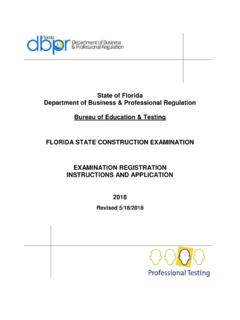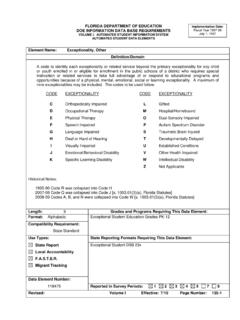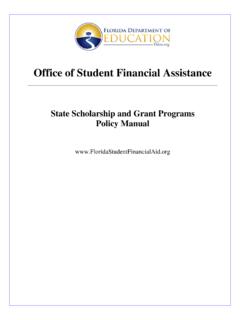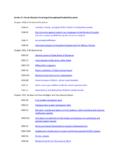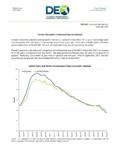Transcription of Florida Department of Education - Aquarelle Kids …
1 Florida Department of Education Voluntary Prekindergarten Education Standards I. Physical Health A. Physical Health Shows characteristics of good health to facilitate learning Demonstrates visual ability to facilitate learning Exhibits auditory ability to facilitate learning Performs oral hygiene routines Shows familiarity with the role of a primary health care provider B. Knowledge of Wellness Shows that basic physical needs are met Follows basic health and safety rules Participates in physical fitness activities Makes wise food choices Performs some self-care tasks independently II.
2 Approaches to Learning A. Eagerness and Curiosity Shows eagerness and curiosity as a learner B. Persistence to tasks and seeks help when encountering a problem C. Creativity and Inventiveness tasks with flexibility and inventiveness D. Planning and Reflection Shows some planning and reflection III. Social and Emotional Development A. Self-concept Demonstrates self-concept Shows some self-direction B. Self-control Follows simple classroom rules and routines Uses classroom materials carefully Manages transitions Page 1 of 5 III. Social and Emotional Development (cont.)
3 C. Relationships with Adults Interacts easily with familiar adults Seeks adult assistance appropriately D. Relationships with Peers Interacts easily with one or more children Develops special friendships Participates in the group life of the class Shows empathy and caring for others E. Social Problem Solving Seeks adult help when needed to resolve conflicts IV. Language and Communication A. Listening Gains meaning by listening Benchmark: Child shows understanding by asking and answering relevant questions, adding comments relevant to the topic, and reacting appropriately to what is said.
4 Follows two- and three-step directions Benchmark: Child has mastery of two-step directions and usually follows three-step directions. B. Speaking Speaks clearly enough to be understood without contextual clues Benchmark: Child s speech is understood by both a familiar and an unfamiliar adult. C. Vocabulary Shows an understanding of words and their meanings Benchmark a: Child has age-appropriate vocabulary in several categories and demonstrates a wide variety of words within each category ( , world knowledge, names of body parts, feelings, colors, shapes, jobs, tools, plants, animals and their habitats, and foods; words that describe adjectives and adverbs; and action words verbs).
5 Benchmark b: Child has mastery of instructional language of the classroom and objects in the classroom ( , same and different, in front of and behind, next to, opposite, below). Benchmark c: Child understands or knows the meaning of many thousands of words, many more than he or she uses. Uses an expanded vocabulary to describe many objects, actions, and events Benchmark a: Child uses a large speaking vocabulary, adding new words weekly. Benchmark b: Child uses category labels ( , fruit, vegetable, animal, transportation, tools). D. Sentences and Structure Uses age-appropriate grammar in conversations and increasingly complex phrases and sentences Benchmark a: Child typically uses complete sentences of four or more words, usually with subject, verb, and object order.
6 Benchmark b: Child uses regular and irregular plurals, regular past tense, personal and possessive pronouns, and subject-verb agreement. Page 2 of 5 IV. Language and Communication (cont.) D. Sentences and Structure (cont.) Connects phrases and sentences to build ideas Benchmark a: Child uses sentences with more than one phrase. Benchmark b: Child combines more than one idea using complex sentences. Benchmark c: Child combines sentences that give lots of detail, stick to the topic, and clearly communicate intended meaning. E. Conversation Uses language to express needs and feelings, share experiences, predict outcomes and resolve problems Benchmark: Child demonstrates varied uses of language ( , requesting, commenting, using manner words, problem-solving).
7 Initiates, ask questions, and responds to adults and peers in a variety of settings Benchmark a: Child follows another s conversational lead, appropriately initiates or terminates conversations, or appropriately introduces new content. Benchmark b: Child provides appropriate information for the setting ( , introduces himself or herself; requests assistance, such as asking for help; answers questions, such as providing name and address to a police officer or other appropriate adult). Uses appropriate language and style for context Benchmark a: Child demonstrates knowledge of verbal conversational rules ( , appropriately takes turns, does not interrupt, uses appropriate verbal expressions, and uses appropriate intonation).
8 Benchmark b: Child demonstrates knowledge of nonverbal conversational rules ( , appropriate eye contact, appropriate facial expressions, appropriate distance in conversation). Benchmark c: Child matches language to social contexts ( , uses volume appropriate to context, addresses adults more formally than he or she addresses other children). V. Emergent Literacy A. Emergent Reading Shows motivation for reading Benchmark a: Child enjoys reading and reading-related activities ( , selects reading and reading-related activities when given a choice, pretends to read to others). Benchmark b: Child uses books and other written materials appropriately ( , pretends to read, looks at books in an orderly fashion, turns one page at a time, goes from front to back).
9 Benchmark c: Child asks to be read to or asks the meaning of written text. Shows age-appropriate phonological awareness Benchmark a: Child combines words to make a compound word ( foot + ball = football ) and deletes a word from a compound word ( , starfish - star = fish ). Benchmark b: Child combines syllables into words ( , sis + ter = sister ). Benchmark c: Child can delete a syllable from a word ( , trumpet trum = pet or candy dy = can ). Benchmark d: Child combines onset and rime to form a familiar one-syllable word with pictorial support ( , when shown several pictures, and adult says c + at, child can select the picture of the cat).
10 Page 3 of 5 V. Emergent Literacy (cont.) A. Emergent Reading (cont.) Shows alphabetic knowledge Benchmark a: Child recognizes almost all letters by name ( , when shown a group of letters, can accurately identify the letter that is named). Benchmark b: Child names most letters ( , when shown a letter, can accurately say its name). Benchmark c: Child names some letter sounds ( , when shown a letter, can accurately say the sound the letter makes). Benchmark d: Child recognizes some letter sounds ( , when shown a group of letters, can accurately identify the letter of the sound given).
